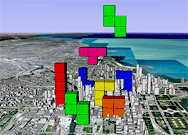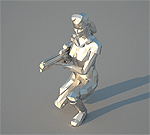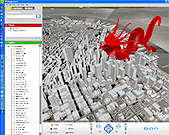- Author(s): Michael Frumin
- date: 2006-01-04
- Link: http://ogle.eyebeamresearch.org/
With the introduction of Google’s popular Googlemaps platform, along with the Google purchase of the easy-to-use 3d modelling software Sketchup, the physical world has taken another step in its current process of algorithmization of physical space (cf. Google Maps Mania). The world is being interfaced for massive topological search, analysis, and construction algorithms, which will obviously be coupled in no time by robotic construction devices (cf. I’ve heard about). But where Google Maps is the rationalization of the world through 3d modelling, Ogle is its de-rationalization, its cultural mashup, allowing for the incongruous logic of cut&paste to infect of the physical world with ontologically incompatible artefacts. A 3d video game dragon escapes from its plot and invades the online community Second Life, a Tetris drops down from the sky to interface itself with available space left by city planners, Counterstrike players record a portrait of their avatar during gameplay and turn the resulting model into a solid figurine via rapid protoyping machines.



Ogle is an OpenGLExtractor, in other words it extracts 3d models represented in real time via OpenGL. 3d snapshots can be made for example from a scientific simulation, and mixed into a scene captured from a video game. Anything that can be represented in three dimensions through OpenGL, can be extracted from its environment and then brought into another 3d modelling or real time engine for mashup fun. As almost all contemporary computers are capable of rendering models and environements with OpenGL, a huge library of 3d content suddenly becomes accessible via Ogle.
Ogle is a fairly explicit technical illustration of the principle that computers are reversible machines, giving users access not only to fixed representations via algorithms, but access to the algorithms themselves via interactivity.
Ogle also illustrates the constantly calculated nature of 3d models, and the manner in which these models are more potentialities than fixed media objects. Although a real time three dimensional terain may have been modelled click-for-click by a designer — essentially the digital equivalent of building an image by hand — it must still be sent to the computer as a dynamic model, ready for manipulation if there is to be any interactivity with it. Even if the model itself does not topologically modulate, any change of perspective will require the computer to essentially recalculate the entire image with all of the resulting changes in lighting and visibility. For example, in order to save precious processor cycles, OpenGL in most cases does not draw any line, point or plane that is invisible to the point of view — all of which must be recalculated for each change of perspective. Because of this, the entirety of the model as a series of OpenGL commands must be available to computer.
The important term here is “command”. An OpenGL 3d model is not a series of fixed coordinates for drawing lines and planes. It is more a series of instructions on how to get to those coordinates and what sort of geometric shapes should be drawn there. These are iterative instructions and must be built line-by-line, block-by-block, plane-by-plane, with changes in perspective added to this chain of itération as if it were yet another geometric object. This brings us back to the question of reversibility. While the previously mentioned human “modeller” might be building a three-dimensional model without any knowledge of the actual OpenGL commands being sent to the computer, he or she is essentially sending program instructions to the computer and not a fixed series of geometrical points — no matter what is visible to the user in the modelling program.
In order to “listen in” on these commands sent to the OpenGL graphics card (draw a square here, rotate the scene and draw a line there, etc), Ogle merely has to position itself in the communication chain just before the software communicates this information to the graphics card. Although the gesture itself of hacking into this chain of communication is in-and-of-itself a fairly radical proposition, especially given the copyright concerns such reappropriations might provoke for the big-business operators of the video game industry, it is nevertheless a logical consequence of the “live” nature of the OpenGL model. A similar case can be made for machinima which can be considered a realtively close cousin to Ogle.
